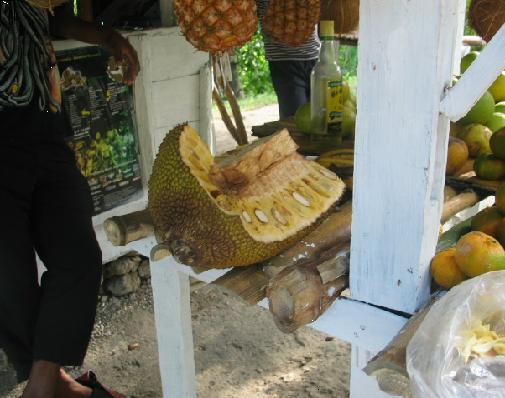 You don't have to be a journalist, just write what you have to say from the heart. All we ask is that you keep it clean. To post your thoughts or pictures, just fill out our simple registration form. Best of all it's FREE!
You don't have to be a journalist, just write what you have to say from the heart. All we ask is that you keep it clean. To post your thoughts or pictures, just fill out our simple registration form. Best of all it's FREE!Let us hear from you...
| « Are Jamaicans to blame for everything criminal? | XVIII COMMONWEALTH GAMES » |
Jackfruit
04/27/06
Jackfruit
Driving to the North Coast my husband always stops at Kent Village along the Bog Walk Gorge just as you pass Flat Bridge to buy jackfruit. It has become a kind of a family tradition over the years and now we look forward to it. It’s amazing but its seems that no matter what time of the year you go you can always get the fruit to buy. You must stop and eat it right away as the jackfruit carries a very high odor. Nobody wants to pluck the fruit as its extremely sticky and the only way to get the stains from your hands is to use cooking oil. Usually my husband gets that job and we all avoid him after as the smell tends to linger once you have touched it.
Follow up:
The jackfruit is not your everyday fruit. In fact I have only seen it growing in Jamaica. I did some research however and found out that it is believed to be indigenous to the rain forests of the Western Ghats of India. It came to Jamaica in 1782, when plants from a captured French ship destined for Martinique were taken to Jamaica.
The jackfruit tree (Artocarpus heterophyllus) bears the largest fruits in the world. Massive fruits develop directly from the trunk and lower branches. Because the flowers and fruits develop directly from the trunk they are termed cauliflorous. The fruits are oval to oblong and vary in weight, according to the variety, from 10 to 60 pounds. Although there are reports that they may occasionally exceed 110 pounds in weight. Since individual jackfruits are composed of many ripened ovaries from many densely packed female flowers, they are technically referred to as multiple fruits.
The Jackfruit tree bears fruit three years after planting. Fruits mature 3 to 8 months from flowering. In Jamaica, an "X" is sometimes cut in the apex of the fruit to speed ripening and improve flavor. The large, cylindrical shaped jackfruit has a rough skin, which is green in colour and is made up of hexagonal fleshy spines. The fruit becomes aromatic and softens when ripe. The inside fruit is yellowish with a sweet taste and aroma. Within the fruit is a fibrous material called the rags. Embedded among the rags are numerous arils, the golden and richly flavoured flesh of the jackfruit. Within each aril is a seed, almost the size and shape of a shelled Brazil nut. A single fruit can contain anywhere from 100 - 500 oval seeds.
In Jamaica, the flesh of the jackfruit is eaten raw when ripe. The flesh can also be blended into a shake or made into jam. The seeds can be boiled or roasted like chestnuts. Mature but unripe fruit can be sliced and cooked. The fruit contains latex so it is a good idea before cutting the fruit to coat the knife and your hands with cooking oil.
In other parts of the world the jackfruit is more widely used. In the U.S. and Europe the jackfruit is canned with sugar syrup and sold in shops that sell exotic products. The seeds, which appeal to all tastes, are boiled and preserved in syrup like chestnuts. They have also been successfully canned in brine, in curry, and, like baked beans, in tomato sauce. They are often included in curried dishes. Roasted, dried seeds are ground to make flour, which is blended with wheat flour for baking. Tender jackfruit leaves and young male flower clusters may be cooked and served as vegetables.
The love of jackfruit tents to grow with familiarity. The smell of a fully ripe fruit in an enclosed space may be quite unpleasant to some. It took a long time for my children to get use to it and now they love it. Just remember to keep it outdoors and have your cooking oil ready.

Sister Mary Margaret
SISTER MARGARET MARY, WHO WORKS FOR A LOCAL HOME HEALTH AGENCY WAS OUT MAKING HER ROUNDS WHEN SHE RAN OUT OF GAS.
AS LUCK WOULD HAVE IT A GAS STATION WAS JUST A BLOCK AWAY.
SHE WALKED TO THE STATION TO BORROW A CAN OF GAS TO START & THEN DRIVE TO THE STATION FOR A FILL UP.
THE ATTENDANT REGRETFULLY TOLD HER THE ONLY GAS CAN HE OWNED HAD BEEN LOANED OUT BUT IF SHE WOULD WAIT, IT WAS SURE TO BE BACK SHORTLY.
SINCE THE NUN ! WAS ON THE WAY TO SEE A PATIENT SHE DECIDED NOT TO WAIT & SHE WALKED BACK TO THE CAR. AFTER LOOKING FOR SOMETHING TO FILL WITH GAS, SHE SPOTTED A BEDPAN SHE WAS TAKING TO THE PATIENT.
ALWAYS RESOURCEFUL, SHE CARRIED IT TO THE STATION & FILLED IT WITH GASOLINE, & CARRIED IT TO HER CAR.
AS SHE WAS POURING THE GAS INTO THE TANK, TWO MEN WERE WATCHING FROM ACROSS THE STREET. ONE OF THEM TURNED TO THE OTHER & SAID, "IF IT STARTS, I'M TURNING CATHOLIC".




Recent comments